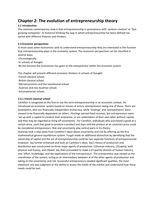Samenvatting
Summary Summaries for Entrepreneurship(EBB106A05) - Book compiled by Department of Innovation Management and Strategy - University of Groningen
Summary of the book "Entrepreneurship". The book is compiled by the Department of Innovation Management and Strategy. Originall, the summaries were written for the subject Entrepreneurship(EBB106A05) of the University of Groningen. The summary consists of the following chapters: 2, 3, 4, 6, 7, 8, ...
[Meer zien]














